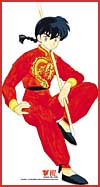by Luis Reyes
Akadot: How has venturing into several genres allowed you to tackle similar themes in different ways? Are there certain themes you gravitate towards that, through different genres, you have been able to explore in different ways? Takahashi: Do you mean several themes in a title and then a comedy or... Akadot: Yeah, accepting the idea that each genre has its own specific vocabulary through which you express certain things in a certain way. Have you found that in each genre, you gravitate towards similar themes, like maybe forlorn love or things like that. Takahashi: I'm not sure what you mean. 'Cause the whole question is do I see similar themes in all of these works? Akadot: Yes, I'm sorry. I guess that is the question. Are you using similar themes and through the different genres, are you able to come to different conclusions about them? Takahashi: I've never really thought about it. I just come up with stories so there might be similarities, but nothing real conscious. Akadot: Well, what's your favorite genre to work in then? Takahashi: Well, I guess I have to say that the easiest to draw would be a love comedy, but the genre that gives me a great deal of enjoyment is horror because I don't get to do it very often. Akadot: Are you going to explore that genre more now? Takahashi: My current series, "Inu Yasha," is definitely not a love comedy. It's my first time doing a long series about monsters and whatnot. I'm really having a good time with it and enjoying myself. Akadot: Do you consider yourself more a storyteller or a visual artist? Takahashi: If I were to choose between one or the other, it'd definitely be the stories. Akadot: I know you've written a lot of manga short stories, but have you thought about maybe producing something that isn't visual based. Takahashi: I don't think of myself as a novelist. I'm a manga artist, and I think story is the most important element in a manga, but that story also has to work with my art, so what's important to me is a story that can be visually told and relate to others. So I don't think I want to do otherwise. Akadot: Among your inspirations, you've mentioned "Spiderman," you've mentioned "Bewitched," things like that. What literary and mythological eras do you usually reference in your work? What non-visual media are you drawn to as inspiration for your work? Takahashi: I guess it's a bit of a bad answer, but everything gives me inspiration. Old old stories. Stories that every kid would have heard as a child in Japan. And folklore that everybody always hears. And in titles like "Urusei Yatsura," anything goes, so I have so many sources for inspiration for that title. Akadot: Do you receive fan mail from your American audience? Takahashi: I get some. Akadot: What kind of things do they note as exciting about your work? Takahashi: Most of the fan letters have the Japanese name of the title that they're writing about and they're kind enough to write in simple English all the way through. But most of the letters seem to be saying how much they love my work and how they enjoy reading it. That's the majority of the letters I get from the United States Akadot: What does the manga style do that the American comic book style doesn't do? Or vice versa? Takahashi: Originally, when the "Spiderman" manga came out in Japan, it was written by an American person and just illustrated by a Japanese artist and I didn't think that the story worked all that well. And I also have a few copies of the American "Spiderman" comic and I can't read any of it, but I look at it from panel to panel. It seems very light and bright, light-hearted maybe. But when the Japanese writer came in to do "Spiderman," it became a much darker and gloomy story and I found myself really interested and drawn in by it. Maybe that says that Japanese manga readers like gory stories (laugh). I don't know. Akadot: What is different between the light-hearted Japanese stories, like your "Ranma 1/2," and the American, light-hearted stories. What freedoms does manga allow that perhaps the American comic books tend to restrict? Takahashi: Well, I can't really say since I'm not all that familiar with American comics, but in Japanese comics, manga, I find that most of the main characters are teenagers, usually from 10 to like 16 or 17, hardly ever any older than that in most instances. And I think most of the readers, being kids, can identify with characters of these ages. Whereas in the typical American comic, most of the characters are adults. Or if they're not adults, they're extremely young, or they're not even human at all. So, I can't say for sure, but I think that might be one of the differences. Akadot: Yeah, I really like that. You've inspired a whole bunch of questions that I'll hopefully be able to ask at another time. Thank you very much. Takahashi: Thank you. In this short and somewhat hurried interview, Rumiko Takahashi - surrounded by protruding floodlights and bustling camera crews- took the time, even after raven-like producers swooped down in consultation, to sign Sandy's "Ranma 1/2" and "Maison Ikkoku" English manga. This may be a small gesture, but it's still a testament to Takahashi's personal generosity and understanding despite the corporate glass behind which she sits. Inu Yasha and Ranma 1/2 © Viz Entertainment.
|

